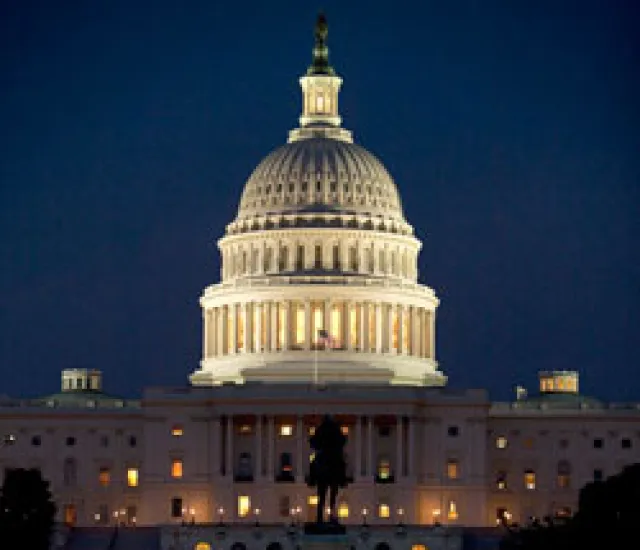Updated: August 2, 2011
The US debt ceiling drama concluded today as President Barack Obama signed the compromise bill that resulted from weeks of frantic, last-minute negotiations between the White House and Republican and Democratic Congressional leaders.
Although a technical default has been avoided and the President has hailed this as the first step towards balancing the US budget, most of the toughest long-term decisions facing the government still have yet to be made. With so many questions open, fears of a US debt downgrade are far from being put to rest.
The impact of a downgrade on markets is a matter of some debate. The interest rate research team at Barclay's Capital laid out a concise argument for a downgrade last Friday in their weekly global rate strategy report, arguing that the amount of savings that any adopted plan could claim was irrelevant, and that the debt-to-GDP ratio was the critical factor from a long-term credit risk standpoint.
Barclay's estimates that it would take over $4 trillion in savings to stabilize US debt at 75 to 80% of GDP by 2021, on their baseline assumptions. As they note, a less ambitious package may achieve little in the long run. "The key is to stabilize the debt/GDP ratio relatively soon – the longer we wait, the more the eventual cuts that will be needed," they point out. When factoring in the many unrealistic assumptions about future growth and spending made in Democrat and Republican plans, as well as the ‘double whammy’ that weaker GDP growth delivers to the debt ratio, Barclay's conclusion is that any plan likely to be adopted in the coming days will fail to tackle the real problems, meaning that the risk of downgrade remains significant regardless of any debt ceiling compromise. They note that this is completely avoidable and that if the US does lose its AAA standing that it will have been "purely self inflicted."
Jessica Hoversen, a strategist at MF Global, pointed out last Friday that while a downgrade now is much more likely than it was several months ago, the timing of any change will depend on more than just the math. "The ratings agencies have already taken tremendous criticism over the timing of recent downgrades of troubled European sovereigns due to the perception that they kept asking for austerity measures which were adopted, but then downgraded them anyway," she states. Hoversen argues that the ratings agencies are still repairing their credibility in the aftermath of the crisis, and that they will seek to avoid the political and investor backlash of lowering the US from AAA until after they have fully exhausted their ability to issue warnings.
Much of the strategic research published in recent days has focused on the thornier question of when, rather than if, a downgrade occurs. In a note put out over the weekend, Bob Savage at Track Research pointed out that the risk of the US losing its AAA status was already largely priced into the bond markets. "The money market cash hoard in response to the fear of default may be the only story of consequence to watch out for next week. In the rest is the noise of a plane whistling in the dark," he said.
A quick scan of the investment mandates of public investors in the US reveals that almost all contemplate US government and agency debt separately from ratings considerations. In other words, the definitions of what state and municipal pension funds can and cannot own in their portfolio list US treasuries and also the bonds issued by Fannie Mae and other government sponsored enterprises regardless of the credit rating assigned to them.
Meanwhile, Barclay's notes that many institutional investors and mutual funds actually weight their credit exposure in manner that will paradoxically require them to purchase more treasuries and sell lower-rated bonds as they rebalance portfolios that require a constant minimum average credit rating by either target or mandate. Simply put, there are not enough AAA bonds besides US treasuries in circulation globally for it to be possible for these investors to substitute other credits so they must sell the lower-rated paper and buy what they can.
Internationally, the unchallenged reserve status of the dollar makes a sudden stampede away from US treasuries unlikely according to most market strategists and academics. As Savage notes, "With fully 53% of the world’s AAA bonds ‘Made in America,’ there isn’t much else ground upon which to land."
One place that the impact would surely be felt is in the derivative markets, as risk and collateral levels are recalibrated by all major dealers simultaneously. This creates the potential for significant near-term volatility. With the risk management changes implemented by banks and other dealers after the Lehman bankruptcy, a sudden storm in those markets seems unlikely to cause serious systemic damage. The collective yawn that met the CME announcement last week that treasuries would be subject to a collateral haircut suggests that the derivatives markets are prepared to take a downgrade in stride.
Does this mean that when the dust settles in a hypothetical post-downgrade universe that the impact will be negligible? That the ground that the markets stand on will merely be an inch lower – with all relative risk factors adjusted down in lockstep accordingly?
One thing that almost all are in agreement on is that most investors will continue to hold US debt regardless of a downgrade, if only for the lack of alternatives.






